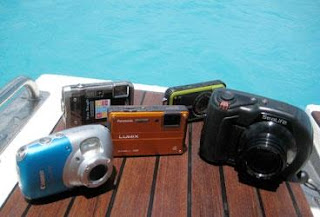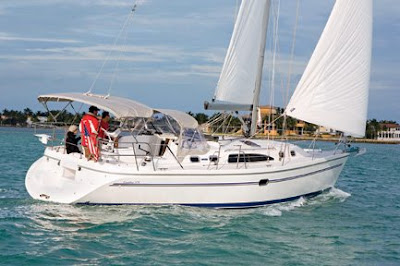Hanse Yachts sure have come a long way since their models first appeared at the U.S. Sailboat show in Annapolis in the late 1990’s. Back then, I thought the boats were small and unremarkable except for the fact that they were built in the former East Germany, but I soon learned that Hanse’s founder and chief visionary Michael Schmidt had big plans. Since then, Hanse Yachts has indeed evolved into one of the highest volume builders in the world. And as I found out during a test sail of the Judel/Vrolijk-designed Hanse 495 on a spectacular late fall day in New England, there are plenty of reasons why Hanse Yachts continue to propagate.
Construction
The hull is built of solid hand laid fiberglass below the waterline and balsa core above the waterline. The deck is cored with balsa. The hull is stiffened with a solid fiberglass grid. Both the hull and deck are laminated with Isophtalic gelcoat and vinyelseter resin. Both the standard T-shaped, and the optional L-shaped keels are cast iron. Overall construction quality was good.
On Deck
The 495 has striking lines—the bow is plumb, the topsides are tall with oversized hull ports, the coach roof is low slung, and the stern is wide. Stepping aboard (several fixed steps on the dock made it easy to get up through the lifeline gate), I liked the easy-to-navigate side decks, though I’d have liked to have seen a longer coach roof grab rail. I was also impressed with the spacious cockpit centered around a large, sturdy table with dropdown leaves. The cockpit seats are wide enough to be comfortable, long enough to stretch out on, and the stainless steel framed table provides excellent hand holds and brace points. The transom drops down to reveal a large swim platform and clever life raft storage. Access through the stern area is excellent due to the boat’s dual helm configuration. Lines led through a bank of stoppers to winches mounted close to the helms make sail trim from both helm stations a snap. The double ended mainsheet and self-tacking jib make it extremely easy to sail single-handed, but there is no traveler. The only way to depower the main is with the vang. On deck stowage is available in the good-sized cockpit lockers under the seats and a large sail locker forward.
Accommodations
The accommodations plan is impressively customizable for a production boat. Three very different basic cabin layouts are offered. The boat I tested had the master cabin forward, two guest cabins aft, and a large sail locker forward, but many different variations, including choices of wood veneers (Mahogany, cherry, or teak) and upholstery colors are available. No matter what version you choose, the main saloon will be open and stylish with a spacious, Euro-style galley, a large settee, and significant (6’10”) headroom. The main saloon is bright thanks to well designed hull ports and well ventilated by four opening ports and two large opening hatches. There’s also room a proper, forward facing nav station with a large chart table and a good sized head.
Hanse pitches the accommodations design as “loft style.” This is readily apparent in the master cabin forward. It has a legitimate walk-around “bed,” generous stowage, and an ensuite “bathroom” that you might actually find in small city “loft” instead of the triangle shaped bunk that you often find in forward cabins on many boats. An equally well proportioned and well equipped master cabin aft is also available, but I’d opt for the superior light and ventilation available forward. The guest cabins are much less “loft-like,” but still have enough berth and stowage space to be comfortable.
Under Sail
I test sailed the 495 off Manchester, Massachusetts, under crisp sunny skies in about 8-12 knots of breeze and flat water during a highly unusual warm spell last Fall. Now while it wasn’t the best day to see how the boat would handle a blow, I can report that it handled the light stuff extremely well. The helm was light and well balanced. I appreciated the tactile feel of the steering and the way hull cut a clean wake through the water. Visibility to leeward and of the jib telltales was excellent from each of the helm stations and the seats were comfortable though they felt a little exposed. I also liked the easy visibility and access to the chart plotter mounted on the back of the cockpit table, and that the crew could both trim and reef without ever needing to go forward.
Upwind, admittedly in a zephyr, I was able to get boat speed to just touch 7 knots, briefly, and we were able to tack through 80 degrees. But speeds in the high 5s and 6s were the norm in the mostly single digit winds. Still, pretty good considering this is a 30,000 pound boat. The 495’s excellent light air performance is really not too surprising considering the low-drag hull was drawn by the go-fast guys at Judel/Vrolijk, the L-shaped, 8,830 pound keel draws almost 7-feet, and even with the self-tacking jib, sail area totaled 1,272 sq ft. And it was easy to sail too. Once the in-mast furling main and self-tacking jib were trimmed for sailing hard on the breeze, all I needed to do was put the helm over and sail to where the tell tales told me to. And if we did need to trim, a powered winch was there to provide the muscle.
Under Power
The standard 72-horsepower engine provides plenty of power and the deep rudder and L-shaped keel provides plenty of maneuverability, but we didn’t really need any of that to get off the dock due to the dual retractable thrusters our test model was equipped with., all we needed to do was deploy the thrusters, and push the joystick (both thrusters are controlled with a single joystick) to the right. The ability to simply power sideways out of a tight spot is cool, but you must to remember to retract the thrusters before accelerating or they will be damaged. There were no surprises once we were powering out of the harbor. Boat speed under power was in the 8-to-9 knot range. Engine noise was noticeable but acceptable down below.
Conclusion
If you ever use words like: classic, or traditional, or transom overhang, to describe your ideal cruising boat, the Hanse 495 is not going to be your cup of tea. But, if you’re looking for a spacious, stylish, well designed boat that’s fun and easy to sail, AND will turn heads on any harbor tour, the 495 may be right in your wheelhouse. It combines attitude and elegance with performance and function beautifully.
Vital Statistics
Headroom 6ft 10in
Berths 6ft 7in x 5ft 5in (fwd)
7ft x 6ft 2in
Specifications
LOA 50ft 6in // LWL 44ft 5in
Beam 15ft 7in // Draft 6ft 9in (std); 6ft 6in (opt)
Displacement 30,900lb (std); 31,900 (opt)
Ballast 8,830lb (std); 9,820 (opt)
Sail Area 1,224ft2 (100% FT)
Fuel/Water/Waste (Gal) 80/172/19
Engine 73hp Volvo (sail drive)
Electrical 1 x 80AH/2 x 150AH
Designer Judel/Vrolijk & Co
Builder Hanse Yachts Greifswald, Germany
U.S. Distributor Hanse Yachts USA, 978-903-0380, usa.hanseyachts.com
Price $368,000 base
Ballast ratio 28
Sail Area/Displacement Ratio 19.9
Displacement/Length Ratio 157






